Sauda 作者: 来源: 发布时间:2021-04-22
一、所属省或是州,具体位置,人口,面积
Sauda is a municipality in Rogaland county, Norway. The administrative center of the municipality is the town of Sauda, where most of the population lives. Other villages in the municipality include Saudasjøen and Amdal. Despite being in the northern part of the region of Ryfylke, Sauda participates in the Haugalandet Council and is under the jurisdiction of the Haugaland District Court.
The 547-square-kilometer (211 sq mi) municipality is the 197th largest by area out of the 356 municipalities in Norway. Sauda is the 190th most populous municipality in Norway with a population of 4,595. The municipality's population density is 9.1 inhabitants per square kilometer (24 / sq mi) and its population has decreased by 2.1% over the previous 10-year period.
The town of Sauda is the fifth largest town in Rogaland county with 4,254 inhabitants (2016), and the city center is home to Northern Europe's largest melting plant, Eramet Norway AS. The municipality is situated in the mountain valleys surrounding the Saudafjorden.
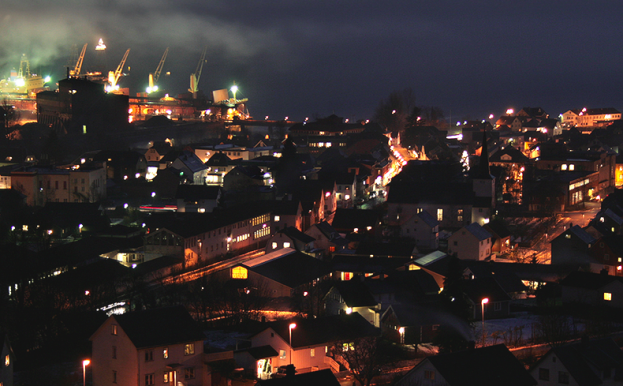
二、自然地理
1.地理条件
Sauda is located in the valleys and mountains surrounding the Saudafjorden. Outside of the main valley, most of the municipality is very mountainous terrain, with mountains like Skaulen (1,560 meters or 5,120 feet) and Kyrkjenuten (1,620 meters or 5,310 feet). The town of Sauda is located about two hours by boat from the city of Stavanger, about three hours by car from the city of Bergen, and about five hours by car from the national capital, Oslo. The mountains surrounding the village of Saudasjøen contain one of the biggest ski resorts on the west coast of Norway. The town of Sauda is located on flat land, a delta created by the rivers that empty into the fjord just outside the town center.
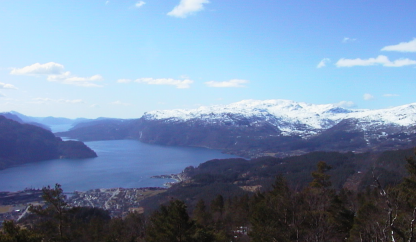
The ice that slid down from the Saudafjellene during the last ice age collided with an oncoming glacier from the Suldalsheiene that formed the Hylsfjord. As a result, the end of Saudafjorden meets Sandsfjorden, which consists of narrow and curved straits (popularly called "Pølsesvingene"). The narrow straits make it difficult for cargo ships over 65,000 tonnes to call at the port of Sauda, and was the main reason why the Germans planned to build a canal between the Saudafjord and the Vindafjord over the Ropeid Peninsula during World War II. At the end of the fjord, the landscape is flat, and goes in plateaus up two valleys. The plateaus are also formed by glaciers from the last ice age for approx. 10,000 years ago. Nordelva and Storelva flow into the fjord from the northeast and northwest, and have for thousands of years formed a delta which in traditional Norwegian is called "øyr". This has given name to the downtown area, which is called Øyra.
Variation in the bedrock also gives variation in the vegetation. The clear tree division in the bedrock is found in the vegetation depending on whether it grows in the bedrock, fillite or sliding cover zone. The vegetation therefore alternates between rich and poor vegetation types. This is clearly visible in several places in the municipality. The high mountains in the municipality are barren, with little vegetation. Forests dominate the landscape with a lot of pine along the fjord and valley sides, but also with some birch. There are several localities of deciduous forest where this has had the opportunity to develop.
2.交通情况
Sauda is the "10-minute city" between the fjord and the mountains, a city in miniature with proximity to everything and offers most things. The tourist information lends free electric bikes to those who want. Please contact us for more information.
https://www.sauda.kommune.no/velkommen-til-sauda/turistinformasjon/
三、经济发展和规模
The main activity is industry, with large companies represented like Eramet, Saint-Gobain, Statkraft, Sauda Building Center, Statnett, Elkem, and Effektivt Renhold. Business activities in Sauda are divided into three main areas: metallurgical industry, power production and other material production such as wood and glass. The main center for Statkraft region south, is located at Vangsnes outside Sauda city center. From here, all Statkraft's power plants in the southwestern part of Norway are managed. The Sauda II power plant will be rebuilt in 2006–2007 into the Dalvatn power plant, and two new power plants are under construction. Saudefaldene received permission from the state to expand the hydropower plants in Sauda. The application that was submitted for consultation was based on a development and upgrade of existing facilities corresponding to 800 GWh more in annual production, but the state decided on 489 GWh.
Sauda Smelteverk is the municipality's second largest employer - only the municipality has more employees. The smelter is operated by the company Eramet (listed in France). In Saudasjøen you will find a number of small and large companies in two industrial areas. Saint Gobain Bøckman as, department Sauda, which produces window panes and bulletproof glass, is the largest. In and around the town of Sauda there are a number of industrial areas, the largest of which is Sauda Business Park. Other business activities in Sauda are furniture, wood processing, mechanical and service industries as well as production of electric power. Operation of shops / stores in the center of Sauda, has taken place since the 19th century.
After the Middle Ages, flowering began in Sauda, as or in the country. Along the fjord, a sawmill was built that took the driving force from waterfall power, which was typical of small places along western fjords. Large-scale production of timber was started, and sailing ships from other parts of the world sailed into the fjord to pick up goods. In the spring of 2005, an old and sunken quay was discovered underwater near Sagfossen in Sønnahavn. Next to the quay was a large pile of ballast stones that the ships had got rid of.
Sauda became its own municipality when Soledal county was divided in two in 1842 to the current municipalities Sauda and Suldal, respectively. Sauda was first named Saude at a time when place names in Norway were "refined". The municipal council later changed its name to Sauda. In the 19th century, a small adventure started with mining in Allmannajuvet. Zinc was extracted there between 1881 and 1899. On the narrow mining road, the ore was transported down to Sauda, where the products were shipped further out into the fjord. Mining was the start of industrialization that was to transform the small western countryside forever. For years, Sauda municipality has worked to bring new life to the historic mining environment. Allmannajuvet is now well located in the project «Norway's National Tourist Routes», and part of the old building that stood there will be rebuilt. Other businesses that Saudabuen ran at this time were the sale of ice blocks that were cut out of Rødstjødna in winter and early spring.
On December 3, 1900, a comprehensive census was conducted in Norway. This census showed that there were 1580 people living in Sauda, and these were divided into four main types of households. The first was farm households. That is, households where people lived and worked on registered land on a farm. In these households, a married couple with children and often some servants were found. In Sauda, these couples were usually self-employed farmers. The other group was people's households. There were small households where often only one or two people who had previously farmed lived. These had given up the farm on certain grounds, and survived on benefits from the new farm owner. It can be called the form of pension of that time.
The third group were homemakers, an underclass of society at the time. These were people who were allowed to rent a small piece of land from a farmer, and they lived off that piece. These were poor people who had to work hard with a lot of extra work around to make ends meet. The fourth and final group was called other households. This was a relatively large group that made up close to 13% of the population, slightly higher than the national average. They lived in ordinary houses and earned money by working for others. Such was the community in Sauda before the industry made its entrance in 1915, and what is today the center at that time consisted mostly of homesteads. But as early as the 19th century, many hoteliers and merchants had established themselves there. In what is today referred to as the "smelter area", there were also established merchants and farms.
The smelter in Sauda, on the other hand, was doing well, and in the 1960s there were over 1,300 employees there. At the same time, the settlement reached a population peak of approx. 6,700 inhabitants. Since then, the population has declined, a curve that points downwards over time. The municipal economy, which has previously been in deficit, has, however, risen considerably in value in recent years. The potential for Sauda to have more inhabitants in the coming years is present, and 2007 was a year of population growth. The problem for Sauda has not been that people move, as it is natural to believe, but that more people die than are born. The municipality has a birth deficit and a moving-in surplus. In 2007, the municipality had 147 newcomers and 133 newcomers.
https://www.sauda.kommune.no/planer-og-horinger/okonomiplan/
四、产业特点重点项目
espite both timber and mining operations, the real industrialization in Sauda did not start until the 20th century, when the construction of the Sauda Smelter began. It was the Americans who saw the opportunity to invest heavily in Norway due to the enormous power resources the country could offer. At that time, the process industry had to be close to the power plants, due to the fact that the power used by the smelters could not be transported too long without great losses. Money-rich and high-ranking men from Stavanger visited farmers all over the municipality and bought up their fall right. It is subsequently claimed that the farmers were deceived, and that they wrote off great values. The most important negotiations were carried out in "Lensmann Tengesdals" house in Toppadalen. This house, which was of great historical value to the local community, was demolished by the municipality in 2005.
In 1915, Union Carbide Corp. started. construction operations in the area that went by the name Klubben, just beyond Øyra (center). In 1923, the trial operation began, and skeptical spectators from Glanahaugen expressed their doubts about whether this would succeed. Two cargo ships, with 1,000 tonnes of ore from a Norwegian mine and coal from England, respectively, delivered the first raw materials needed to fire up "Furnace 2" and "Furnace 3". "Oven 1" was built a year later. Initially, the furnaces produced ferrosilicon, and the factory had 80 employees. After a short time in production, the furnaces were rebuilt to produce ferromanganese, because it was an alloy that sold better on the global market. The number of employees increased considerably in a few years, and a major power development took place in order to be able to supply the smelter with energy. Over the years, land was filled in to meet increased space requirements, for example when the "Sinterverket" (which was to produce sinter, part of the raw materials used in the smelting process) was erected west of the kiln halls. The sinter plant was demolished in 2007 to make room for storage of raw materials, and the current owners buy sinter from foreign producers.
There have been 33 furnaces in operation at the smelter over the years, but today only furnaces 11 and 12 are in operation. Furnace 11 was rebuilt from producing ferrosilicon to ferromanganese in 2004. In the same year, the oldest furnace still in operation, furnace 1, was phased out. Traces and ruins of old open stoves are still to be found in one of the kiln houses, but nothing in the area is protected. Since 2004, Eramet Norway has demolished significant quantities of the old structures that are not in use, such as the cable car track that transported ore from the unloading quay to the storage sites until 1992. Important traces of Norwegian industrial history can be considered lost, but the smelter has first and foremost development and future plans. in mind.
Eramet Norway works closely with the Norwegian authorities, the cities and the local population in Sauda and Porsgrunn. They aim to be an important and natural part of the local community. They are concerned with helping to build robust industrial regions in Western Norway by developing arenas that contribute to community building where they are established.
Sauda Smelter is Northern Europe's largest smelter. The photo was taken in the middle part, southwest of the work. Foremost in the picture is Haakonsgaten Åbøbyen.
Dams were built, pipes were laid, tunnels and mountain halls were blown up. Large industrial halls were built, and the town developed at the same pace. During the 1930s, Sauda had become a city with every conceivable store and service. The owners of the smelter let it drip on the local community in the form of building roads, districts and community centers such as "Sauda Klubb" and « Folkets Hus ».
"Sauda club" were the officials at the smelter's own great hall. In 1999 it was sold to a private owner. The building is made as a large theater / multi-purpose hall with room for 200 guests. The house is, like many of the houses in Åbøbyen, designed by the architect Gustav Helland. A city planner from Stavanger was hired to set up routes for new streets, sewer pipes and power poles. The optimism was great, and based on the drawings you can see that the municipality expected Sauda to develop into a much larger city than it actually was. Among other things, a wide promenade was drawn from the center to Fløgstad, which remained a dream on paper. At Folkets Hus in Skulegata, paintings have been painted on the walls of a Sauda with skyscrapers and large-scale industry that never saw the light of day. But many of the streets and buildings were built, and apartment buildings were built into the quarters. The technical department at the municipality is still working on the basis of these plans, and the development of the city center plan has not stagnated. On the contrary, Sauda has changed more from 1980 to 2008 than ever before, a common feature with many places in Rogaland.
https://web.archive.org/web/20150801204559/
http://kulturscenen.net/
五、风景名胜,景点( attractions)
1. Sauda Church
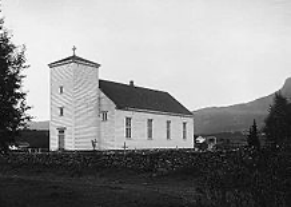
Sauda Church (Norwegian: Sauda kyrkje) is a parish church of the Church of Norway in Sauda Municipality in Rogaland county, Norway. It is located in the town of Sauda. It is the main church for the Sauda parish which is part of the Ryfylke prosti (deanery) in the Diocese of Stavanger. The white, wooden church was built in a long church design in 1866 using designs by the famous architect Hans Linstow. The church seats about 350 people.
The earliest existing historical records of the church date back to the year 1467, but the church was not new that year. The first church was a stave church that was located in the village of Saudasjøen. In 1624, a new tower was added to the old church building. In the mid-1700s, the old church was in need of a renovation, so the old choir was torn down and rebuilt. In 1806, the church was again renovated. This time, the whole building except for the choir was torn down and rebuilt. After the renovation, nothing was left of the original medieval stave church.
In 1864, the parish decided to move the church site to the larger village of Sauda, about 3.5 kilometers (2.2 mi) to the northeast. The new church was completed in 1866 and it was consecrated on 26 September 1866 by the parish priest P. R. Hoffgaard on behalf of the Bishop Jacob von der Lippe. The old church was closed after the new church was completed and then in 1868, the old church was torn down and its materials were sold to some farms in Finnøy. The land where the old church once stood remains as a graveyard.
2.Allmannajuvet
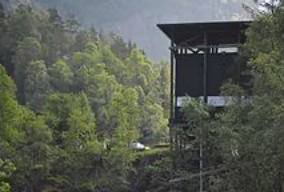
Allmannajuvet is a ravine or canyon located along the river Storelva in the municipality of Sauda in Rogaland county, Norway. The ravine is located in a rural, forested area along the Norwegian County Road 520 between the town of Sauda and the village of Hellandsbygda. This was the site of a large zinc mine which began operations in 1881 and closed in 1899, due to the changing market prices of zinc and high extraction costs. At its peak, the mine had 160 employees and was a major part of zinc exports from Norway.
In 2001 Peter Zumthor was commissioned by the Norwegian road administration to design a rest area, museum and cafe. After a long period with planning and design changes, the construction started in 2008. It should take 8 years before the project was finished, but in September 2016 the official opening was held. The museum is open for visitors in the summer time from June-August, and for groups ordering in advance the rest of the year. Three buildings are finished, and only the old path leading to the mines are yet to open. During a flood in 2014 parts of the path and a bridge were washed away, and work is now under way to repair the damage. The former mine site is maintained as an annex of Ryfylke Museum.
3. Hustveit
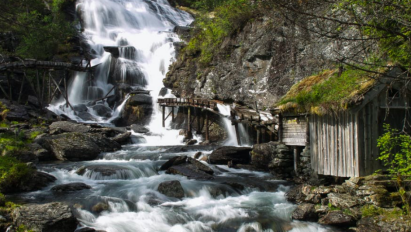
Hustveit is an exciting nature, culture and outdoor area. Both the cultural landscape around the museum garden and the building itself with the furniture in the main building stand out as original and authentic, as it was at the end of the 19th century.
There are many buildings on Hustveit, in addition to farmhouses, barns and barns, there is a firehouse, earthen cellars of natural stone, and a water house on the farm.
The modernization that one got on the farms in the interwar period, and especially after the war, never came to Hustveit. For example, artificial fertilizers or motorized travel cabinets have never been used on the farm. The field around the garden is today classified as a landscape conservation area, and a separate plan exhibition has been set up about the cultural landscape along the hiking trail.
https://ryfylkemuseet.no/anlegg/jonegarden-pa-hustveit/
六、历史文化
1.历史
The municipality of Sauda was established in 1842 when it was separated from the large municipality of Suldal. Initially, Sauda had a population of 1,584. The municipal boundaries have never changed. The municipality declared the urban area of Sauda as a town in 1999. The municipality (originally the parish) is named after the old Sauda farm (Old Norse: Sauðar), since the first Sauda Church was built there. The farm is now part of the village of Saudasjøen. The name is the plural form of sauðr which means "spring" or "issue of water". Before 1918, the name was written as "Saude" or "Søvde".
The coat of arms was granted on 14 May 1976. The arms show three, vertical, jagged, silver / white lines on a blue background. The jagged lines symbolically represent a river as a means for hydroelectricity. Historically, power was generated by watermills, providing a possibility for the development of an industry in the village. Presently, the power is used for melting metal ore in smelters in the municipality.
Archaeological excavation in Saudasjøen shows that people have been living in Sauda since the latest Ice Age. In 1349, the Plague / Black Death wiped out about two-thirds of the population in Sauda, causing a decline in both population and economy. Despite this, the population was increasing during the medieval period, and a new type of industry started to grow. Along the fjord, the power from several waterfalls was used to build and run sawmills, and large-scale lumber production was started. People from all over the world, especially from the Netherlands, started to trade with the people of Sauda. This resulted in major ship traffic, giving impetus to further development of the villages and farms in Sauda.
By the end of the 19th century, a new type of adventure would change the lives of the inhabitants forever. The mining industry started in the mountains of Hellandsbygd, making Sauda a small industrial area and trading center for the surrounding region. In 1910, the American company Electric Furnace Company (EFP) began the construction of Europe's largest smelting plant here in Sauda. This could only be done because of the large number of waterfalls and rivers that made it possible to build power plants situated a short distance from the smelter, which uses large amounts of electricity.
Sauda's time as a farming village was now over, and the people of today still live on the foundation of the new town that emerged. By the end of World War II, the Germans had finished building a large Aluminum Melting Plant in Saudasjøen, but the production was moved to Årdal in 1946. The remaining buildings were demolished by the municipality in the 1950s, leaving the industrial area in Saudasjøen empty for decades. In the 1980s, a glass production factory was established together with a couple of mechanic production factories. The population of Sauda reached its peak in the mid-1960s, approximately 6,700 inhabitants. In 1998, the urban area of Sauda was declared to be a town (mostly a symbolic name, with no new municipal authority).
2. 文化体育
Sauda has a well-developed nightlife, which is suited for all adult ages. There are young-adult bars, as well as more mature-adult bars accessible. A movie theater, many tourist attractions, and restaurants exist as a way of relaxing after skiing. However, the most highly recommended first stop is the après-ski at Sauda Skisenter. Also notable athletes, alpine racers, and summer-winter athletes call Sauda home.
Sauda Skisenter is a winter sports center located on a mountain above the village of Saudasjøen and about 5 kilometers from the town of Sauda in Rogaland, Norway. The base of Sauda Skisenter, formerly known as SvandalenSkisenter, is at an altitude of about 360 meters above sea level. Visitors can reach 1100 meters by taking the T-bar lifts to the top. Surrounding mountains reach up to 1500 meters. Sauda Skisenter was built in 1968, has a large base lodge, and offers ski / snowboard / telemark and other equipment rentals. It is a scenic and snow-rich family venue that offers extreme skiing peaks and a terrain park, with multiple half-pipes, big jumps, rails, and rolls with a skier-cross course. Recently, Sauda Skisenter proposed to spend $ 2,000,000 on a new chairlift which would greatly encourage a lot of extra tourism. Ski-in and -out mountain cabins were built in 2002 around the ski area. Popular places to stay are Sauda Fjordhotell (built 1915) and Kløver Hotel.
The Sauda municipal council has decided to work on the basis of a vision to become number one in leisure all year round, and has, among other things, Rogaland's largest ski center (Sauda Ski Center), shooting range, cross-country arenas, ski jumps, cross track, stadium with a gravel track and a grass track , ball bingers, halls for football, handball, gymnastics and other sporting events, swimming pool and summer open outdoor pool. In the first half of the 20th century, gymnastics was very strong in the city, and several championships were held at Sauda Turnhall.
In the 1920s, the sport of jumping came to Sauda, and then the city also got its first ski jumping hill. The sport of tennis has also been strong in Sauda, and the town has several outdoor tennis courts. In recent times, swimming, athletics, cheerleading, football, handball, floorball and weightlifting have been among the sports that have fostered top athletes. The place has long traditions with sports through two sports teams, Sauda Idrettslag (SIL) and Ny-Von, respectively. Nihull golf course at Grønsdal in Saudasjøen.
Sauda's municipal coat of arms is on blue ground, with three white zigzag stripes indicating a waterfall. The municipality has a long tradition of utilizing power from waterfalls and rapids in the area, from sawmills and mills in the Middle Ages to modern and energy-intensive industry.
The municipality's millennium site is Rådhusplassen located in front of the City Hall in the center of Sauda. No decisions have been made by the municipality on what will be set up on the millennium square, but the official plan is to erect a 20 meter high sculpture that will symbolize a waterfall in line with the motif on the municipal coat of arms and the natural resource that has both named and life to the city since the 17th century.
七、其他信息
All municipalities in Norway, including Sauda, are responsible for primary education (through 10th grade), outpatient health services, senior citizen services, unemployment and other social services, zoning, economic development, and municipal roads. The municipality is governed by a municipal council of elected representatives, which in turn elect a mayor. The municipality falls under the Haugaland District Court and the Gulating Court of Appeal. The municipal council (Kommunestyre) of Sauda is made up of 19 representatives that are elected to four year terms.
八、联系方式
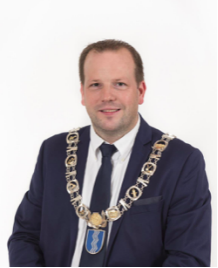
Town manager: Asbjørn Birkeland
Phone:52 78 63 00
Address:Rådhusgata 32, 4200 Sauda
https://www.sauda.kommune.no/politikk/ordforer/
